Field fortification in the civilian - Kakhovsky bridgehead and its operational value. Part of 1
The Russian army, which was revived on the Crimean peninsula from the VSYUR forces, was reorganized, replenished with people and equipment. PN Wrangel managed to achieve serious results - by the spring of 1920, his army was a well-knit and equipped combat organism.
The June strike on the troops of the red 13 Army was dealt in two directions simultaneously. The right group, the 1 Army Corps, landed troops on the northern shore of the Sea of Azov, captured Melitopol, and began to advance north and northeast. Left group - 2-i Army Corps and cavalry, coming out from behind Perekop shaft, June 7 attacked the red Perekop group, crashed between its divisions and, separating them into two parts, pursued retreating troops in two directions: to the north - Black Valley and Kakhovka and the northeast to Agayman and Belozerka.
The rollback of parts of the 13 Army stopped on the line Belozerka, Mikhailovka, B. Tokmak. But the units of the Perekop group, which departed from Perekop to Kakhovka - Berislavl (52 and Latvian rifle divisions), were isolated from the rest of the army and, unable to stay on the left bank of the Dnieper, crossed the town of Berislavl to the right bank.
By June 12, P. N. Wrangel, capturing northern Tavria, planned to capture Aleksandrovsk and the Donets Basin. White decided to use the lower reaches of the Dnieper from Nikopol to the estuary as a natural cover for their communications, and, pushing the red units to the right bank, put up strong infantry and cavalry units with artillery and reserves in the Serogozya and Chaplinka areas. Since the 15 and Latvian divisions located on the right bank were cut off from the 52 army, the army command united the troops on the right bank into a special group.
The right-bank group initially received a passive combat mission - to guard the Dnieper line from the mouth to the lake. Babino.
Thus, on the lower reaches of the Dnieper, opponents confined themselves to observing and guarding the banks of the river, disturbing each other with raids and reconnaissance searches.
The fierce battles that took place in the main line of the Russian army’s offensive in June-August 1920 between the eastern bend of the lower reaches of the Dnieper and the Sea of Azov showed the red command that no frontal offensive would result.
The command of the Southern Front chose the direction for the main attack. It fluctuated between the directions: a) Berislavl - Chaplinka - Perekop and b) Berislavl - Voznesenka - Melitopol. The first led to the Perekopsky isthmus and threatened the Crimea. The second brought out to the communications and to the rear the main forces of the Whites operating in the Aleksandrovsky and Orekhovsky districts. The starting point for both directions was the city of Berislavl, where there was a floating bridge (though destroyed) across the Dnieper.
It was decided to use both directions - depending on the prevailing situation. But at first, the troops of the right-bank group faced a difficult task - to force the Dnieper, to strengthen on its left bank, to organize reliable ferries and to protect them from the blows of the whites.
The value of the Berislavl ferry by white was also taken into account - in this area the Dnieper was defended by units of the Y.A. Slashchev 2 Army Corps. The red right-bank group consisted of 52-I (up to 3 thousand fighters), Latvian (up to 5 thousand soldiers) divisions, Kherson group and Nikopol garrison (600 people).
The first attempt to force the Dnieper occurred in early July.
On the red side, two brigades of the 1 division and a brigade of the Latvian division took part in the battles of 4-52 on July 4 at Berislavl. The arrows of the 156 brigade and Latvians who crossed the Dnieper River pushed the advanced outposts of the whites away from the plaques and occupied the large and small Kakhovka and the Hut. Terns. The Berislavl Bridge was repaired.
On the night of July 4, whites pulled up parts of the Markov division, attacked the positions of Latvian riflemen and forced them to retreat to the other side. After the departure of the bridge was blown up.
One of the main reasons for the failure of the first attempt to seize the bridgehead (assuming the Reds were tactical surprise) was the inept management of the units that had flown to the left bank - they had no general command, and control was carried out from Berislavl via telephone wires stretched across the bridge.
During the pause, the Kherson group and the Nikopol garrison were merged into the 52 division. The 51-I and 15-I divisions were transferred to the right-bank group. The 51 Division, which arrived from Siberia, had up to 11 thousands of fighters and had good artillery. The 15 Division, which suffered great losses in northern Tavria, was replenished and had up to 5 thousands of fighters. R. P. Eideman was appointed commander of the right-bank group.
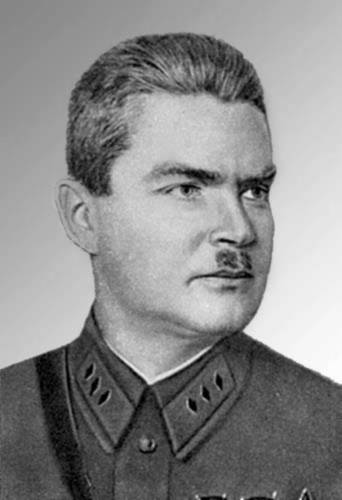
Il 1. R.P. Eideman.
Il 2. South Front by August 1920
The decision to repeat the crossing turned out to be the right one: White did not believe in the possibility of a second strike by the Reds in this direction.
The 52 Division, leaving one of its regiments on the right bank of the Dnieper, concentrated in the Berislavl area by August 5. The Latvian division, replaced on its site by the 15 division, was pulled here. By August 5 in Berislavl arrived the day before unloaded at the station. Apostolovo 2 special purpose heavy artillery battalion (TAON) and the fleet of the 1 pontoon battalion.
Despite the precautions, whites received information about the concentration of the red parts in Berislavl. The headquarters of the 4 division arrived in cars on the night of August 52 in Berislavl and was fired at by batteries that hit the sound of the engines on the pre-shot streets. 5-6 August 3-4 white aircraft were continuously sweeping over the city and its surroundings.
Forcing the Dnieper at Berislavl was scheduled on the night of August 7. The objectives of the divisions after the transition to the left bank: 52-y to take the Big Kakhovka and der. Lyubimovka, and Latvian - to capture Malaya Kakhovka and the khut. Terns.
Having discovered the crossing of the 156 brigade, White outposts opened intensive rifle-and-machine-gun fire. But by 5 hours, two forward brigades were on the left bank.
During the crossing, the red artillery conducted 20-minute artillery preparation - on white batteries and on pre-shot trenches. This caused a strong return fire - on artillery positions and Berislavl. T. o. this distracted the attention of the white artillery from the infantry crossing.
By 12 hours, both divisions were on the left bank and advancing to expand the future bridgehead. By 16, the whites began their retreat to the south-east and south to the Black Valley.
Kakhovsky bridgehead was captured.
Now he had to expand, strengthen and use as a starting position for striking.
On August 8, units of the 52 Division continued to move eastward and by the evening captured Lyubimovka, while the Latvian Rifle Division was advancing southward toward Black Valley.
The White Command took countermeasures: on August 10, the Reds air reconnaissance reported movement in the direction of Voznesenka, 45 versts west of Melitopol, white columns 15 versts long. These were parts of the equestrian corps of I. G. Barbovich.
Parts of the Kakhovka group were pulled to the bridgehead, almost all divisional artillery was also concentrated on the bridgehead, while the TAON remained on the right bank and provided the flanks of the bridgehead.
The white cavalry units that approached the bridgehead did not dare to attack it and, pushing aside the red divisional cavalry, marched along the southeastern sector of the external line of defense and retreated southward to the Black Valley - Chaplink. The white cavalry commanders decided that it was not a matter of cavalry to take fortified positions.
In the future, there was a continuous engineering strengthening of the bridgehead and its combat use, depending on the situation.
In technical terms, positions were not an example of excellence, but the fact of the existence of a bridgehead played an important role. Red managed to keep the crossings across the Dnieper - at Berislavl and at Kakhovka. Maneuvering ability was provided.
The first consequence of the appearance of a bridgehead was the diversion to it of significant white forces from the main operational direction. Nearly the 2 Army Corps was deployed to the bridgehead, and its 13-I and 34-I infantry divisions surrounded the bridgehead with a semicircle. The main task of this compound was the elimination of the bridgehead.
The Red Kahovka group itself conducted active actions, inflicting short white blows to White. The first major operation of the Kakhovka Group was an attack in the second half of August on Voznesenka - Lower Serogozy. The task of the operation: a) by moving in the Melitopol direction to hit the communications of the main forces of the whites and, if possible, cut off their Alexander group from the Crimea; b) to connect with the 2 th Cavalry Army, which, having broken through in the area of the village of Vasilyevka, was going to join up with the Kakhovsky group.
The 51-rifle division was advancing along the Kakhovka-Melitopol highway; the 52-division was moving to the left. The Latvian division was advancing on the Black Valley - Chaplink.
After persistent battles in the Dmitrievka, Antonovka, Konstantinovka area, the Kakhovskaya group advanced to the Ataiman, Nizhnye Serogozya, Aleksandrovka, Pokrovskoye lines, having traveled about 60 versts - half the distance from Kakhovka to Melitopol.
The Whites launched a counter-offensive, bringing the best units of the 1 Army Corps into battle: the Markov and Drozdov divisions with the support of cavalry. They managed to bypass the flanks of the group. White cavalry from the side of Rubanovka carried out a raid on the headquarters of the 52 division, located in vil. Upper Torgayevka. At the same time, violent attacks were carried out on the red infantry units, whose flanks could not withstand the blows and began to retreat.
At this point, the 2-I Cavalry Army, pursued by the 2-th Consolidated Don Cossack Division of V. I. Morozov, was in the area of Menchekur - B. Belozerka. Due to the unfavorable situation created for the Kakhovskaya group, the commander of the station, the chief of the 51 Infantry Division, V. K. Blucher, gave the order to withdraw to the Konstantinovka, Antonovka, Dmitrievka line. And at night Kakhovskaya group was assigned to the bridgehead.
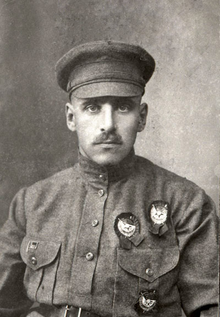
Il.3. V.K. Blucher.
The 2 units of the Cavalry Army began to arrive at the beachhead. White attacks on the western and southwestern sectors of the bridgehead with concentrated fire were repulsed.
2 arrived at the headquarters of the 6nd Army Corps tanks and a significant number of armored vehicles, and the white command decided to seize the bridgehead with their help.
For two days, White carried out artillery shelling of the trenches of the southern and southwestern sectors, and a number of demonstrative attacks with the use of armored vehicles were carried out. Squadrons numbering from 4 to 12 airplanes made several raids a day on Kakhovka and Borislavl: headquarters, wagons, bridges across the Dnieper were bombed.
But the attempts of white pilots to destroy the bridges were not crowned with success - and the bombs were torn in the waves of the Dnieper, raising huge columns of water, and causing anxiety to the bathing horses and compatriots.
This was followed by a night tank attack bridgehead.
September 5 tanks moved in the direction of the hut. Kulikovsky, and behind them went the white infantry. The armored turtles, tearing up the wire obstacles, headed towards the Bolshaya Kakhovka deep into the beachhead. But the shooters remained in the trenches, firing at the infantry, which, following the tanks, tried to penetrate the bridgehead. The rescued white infantry doomed the operation to failure.
On the bridgehead were only tanks, and two of them remained on it. The next day, both damaged vehicles were delivered to the Bolshaya Kakhovka, where a spectacle of overseas monsters gathered crowds of civilians and Red Army men.
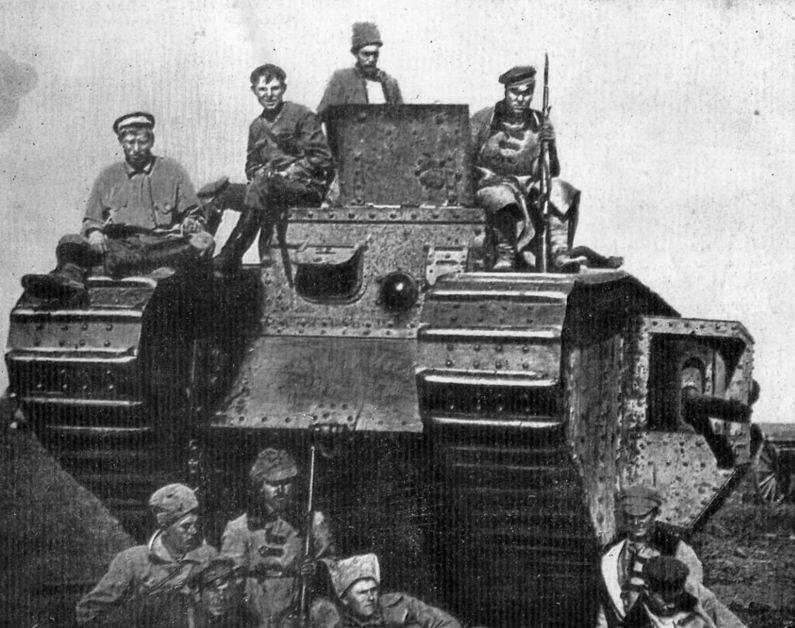
Il 4. Trophy of fighters 51-st.
By mid-October, the White Command decided to preempt the offensive of the Red Army. At Aleksandrovsk, it transferred part of its forces to the right bank of the Dnieper and launched an offensive in the western and north-western directions. The oncoming battles of the equestrian group NG Babiyev, which collided in the region of vil. Sholokhovo with 2-th Cavalry Army.
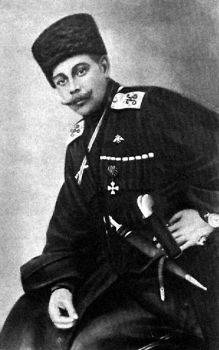
Il.5. Lieutenant-General N. G. Babiev, died at the village. Sholokhovo
To assist the right flank of the 6 Army, the Kakhovskaya group received an order to go on the offensive in the south-east and south. But the offensive was unsuccessful. The Kakhovka group of troops, advancing 15 versts, were detained by the whites' counter-offensive and retreated to their original position.
October 14 began the last assault on the bridgehead. The Whites planned to destroy the Kakhovskaya group, and, by blowing up the bridges, to prevent the planned offensive of the 6 and 1 of the Cavalry armies against Perekop.
Il 6. October assault bridgehead assault
In addition to the 13 th and 34 th infantry divisions of the 2 th army corps, the Czechoslovak regiment, the Cavalry Simferopol division, put into battle, up to 10 tanks and the same number of armored vehicles.
This time they managed to knock down the Reds from the outer line of defense in the southwestern and southeastern sectors. White tanks, supported by infantry, penetrated the bridgehead, moving between the outer and inner lines of defense.
The Latvian and 51 divisions launched a counterattack, and the whites retreated. The 4 of the tank was hit and remained on the bridgehead.
Thus, White failed to destroy the bridgehead and the ferries he hid behind. This had the most important operational-strategic consequences — two weeks after this battle, the 1 th Cavalry Army passed through Berislavl and Kakhovka and the general offensive of the Southern Front began, ending with the evacuation of the White troops from the Crimea.
The Kakhovsky bridgehead proved the expediency of using fortified positions even in the conditions of the Civil War - both for defensive and offensive operations. Kakhov’s positions became the core for offensive operations of the troops of the right-bank group, and then the 6th and 1st Cavalry armies. And the white technique is tanks, armored cars, artillery, aviation - acting against the relatively weak fortifications of the bridgehead, it was not able to overcome the resistance of its defenders.
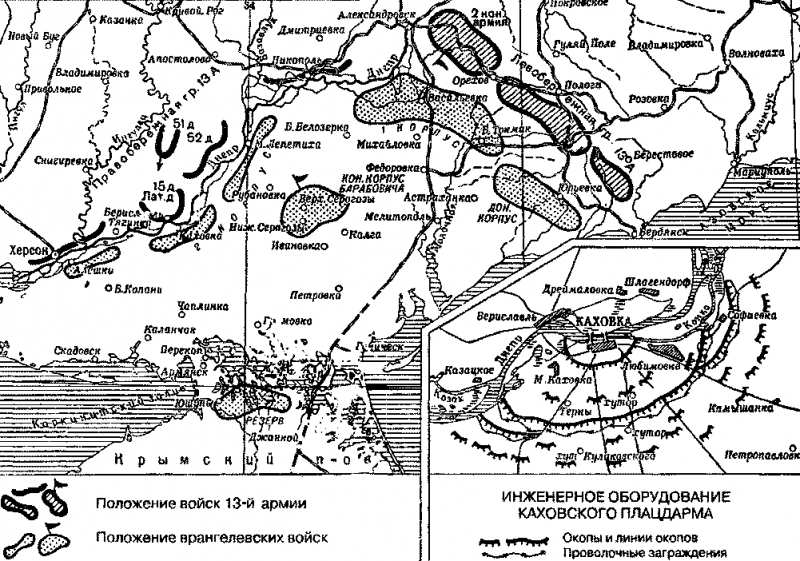
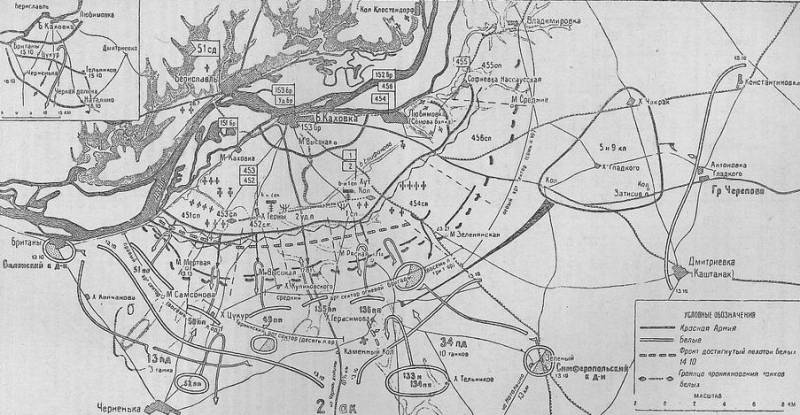
Information